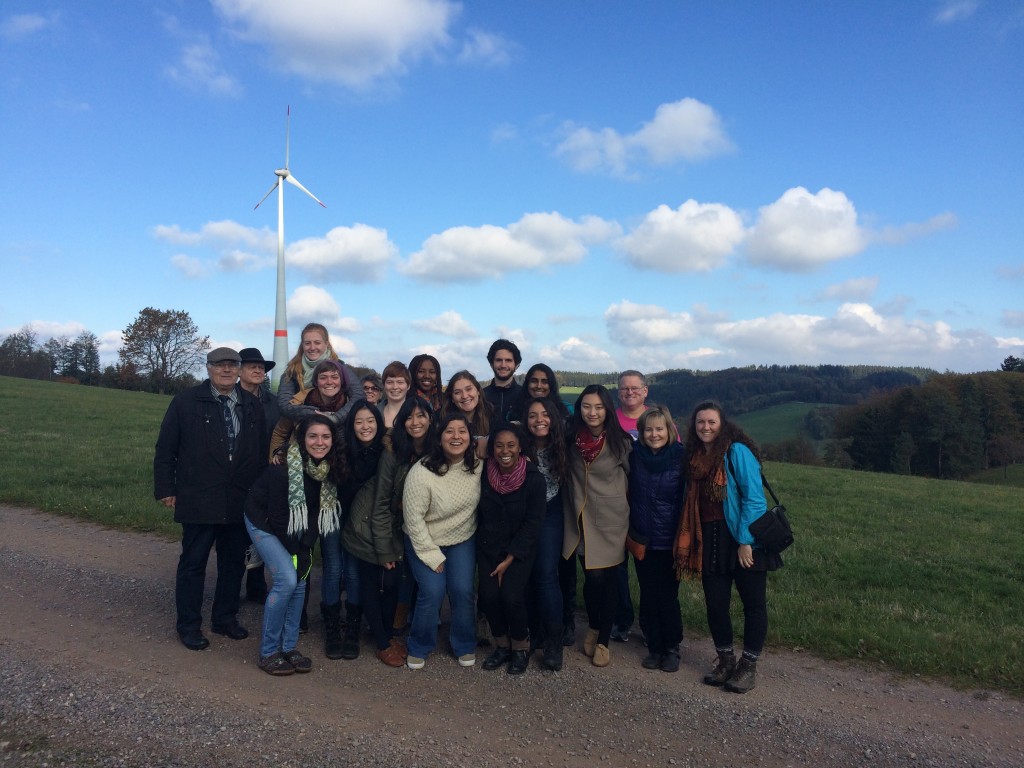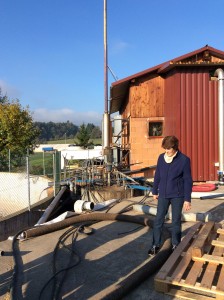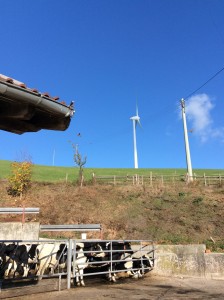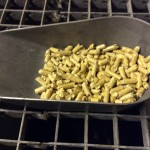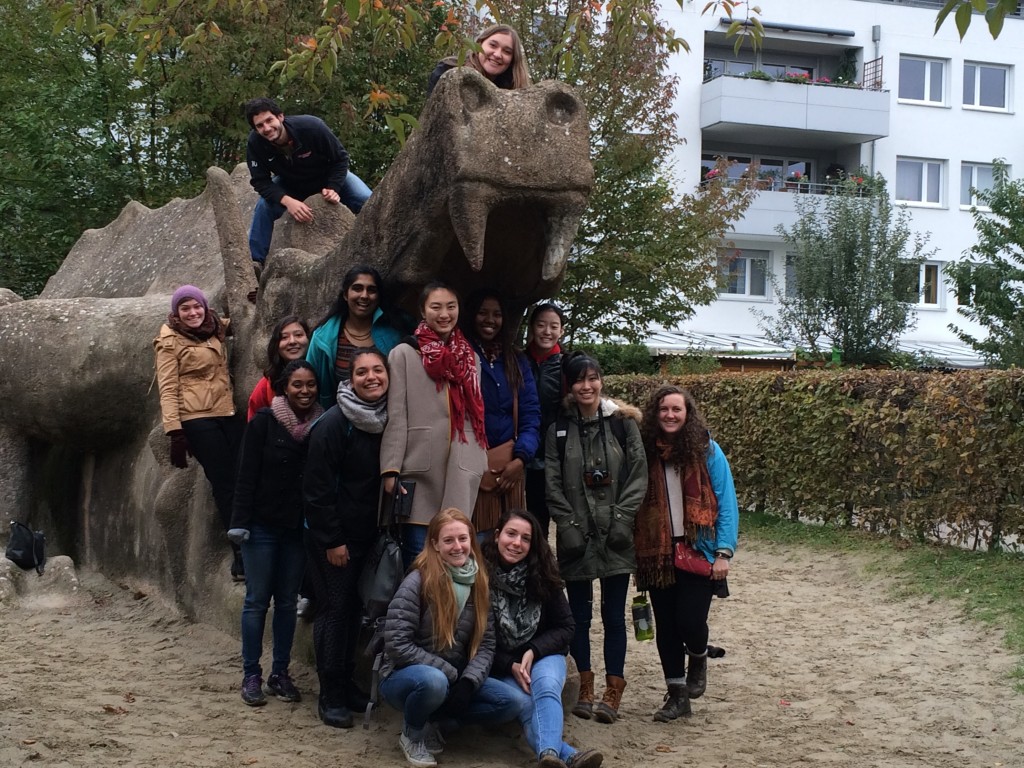Wantonly burning
carbon, Lufthansa flies us
home for Thursday class.
Tag Archives: Renewable Energy
Don’s Daily Haiku
Quote
Turn to sun for light,heat & power, but keep coolshade insulated.
Getting Sunshine (Finally!)
When we woke up this morning, there were hopeful hints of blue skies behind the clouds, and by the time we had boarded our bus (the only private transportation we’ll take the entire trip), there were definite rays of sunshine. Today’s itinerary included several farms and other sites off the beaten track, including a series of windmills in the Freiamt region.
The community of Freiamt produces 200% of its electricity needs (twice as much as it needs each day) from renewable energy sources. We started our day by visiting a biogas plant that makes use of co-generation technology, allowing it to produce both heat and electricity by fermenting grass and manure gathered from the land, then burning the gas. The plant produces over one million kilowatt hours of electricity annually, and heats 19 apartments and the local elementary school.
The second farm we visited is more self-contained, where the wood pellet heating system is used to heat the house, and freshly collected milk is used to warm the household hot water (another example of heat transference co-generation). “This is apparently a 20-year-old technology that everyone has, and it’s mind blowingly obvious,” Mercedes explained. Reflecting further on the contrast between today and the rest of our trip, she notes “they have all of these technologies… at these places that are still farms. In my head, farms aren’t industrialized. But the idea that we have to use everything, in a pre-modernized lifestyle, is following this new sense of energy and renewable resources. We have all this stuff that we’re using so that it doesn’t go to waste. In Philosophy [class] we’ve talked a lot about modernization being finding new ways of needing unnecessary things. In this sense, [the renewable energy] technology is being created so as not to be wasteful, which is super cool.”
Rina, our other commentator, also found a lot of opportunities today to think about the bigger picture: “In class, Professor Dostal got us thinking about how much we are supposed to depend on technology, but I’ve realized that it’s all human connections that make this technology work. 108 people contributed to fund [one of] the wind turbine[s] we visited,” which is just a piece of technology. In class, the discussions have been around whether the possibilities include a human/technology co-existence or co-dependence, and whether human ability will be taken over by technology, or will be able to keep it in check. Rina thinks the success of Freiamt may mean that the connection is a balanced one.
The second half of our day was spent in the neighboring villages of Wyhl and Weisweil, home of the anti-nuclear protests of 1974 we’ve been referring to throughout the trip. Professor Carol Hager has done substantial research in the region, and she had the opportunity to present on her recently published book (NIMBY is Beautiful) to some of the people who are featured in it. First, though, we met with the vice mayor, who gave a brief overview of the protests. Rina has been impressed at the access to interesting people we’ve been granted, mostly through the connections of our faculty, and the Innovation Academy. “We got to talk to these bad ass women who kept a nuclear plant from being built – it’s everything we tell ourselves [as Mawrters] we want to be and everything we are told we can be, and the vice mayor was just there, telling us about it,” she said, about the interaction we had with the Women of Wyhl, who formed the backbone of the protests, since their bosses were more lenient, and their families were depending on their success.
After the book party, on our bus ride home, the class chatted about their takeaways from the day. These conversations often compare the German approach to US policy, but Mercedes realized that “our tours have been in villages and smaller places. We keep trying to apply things from St. Peter to Boston, but you’d have to get to a smaller suburb to draw the parallel. Going back to citizen engagement and involvement, the lessons here can’t be applied just anywhere.” Though it sounds a little down, she suggests that each community is an opportunity for someone to figure out the right set of circumstances and incentives to effect change in that particular space. Tomorrow, we will have more opportunities to learn about such initiatives, as we tour a solar-powered soccer stadium, a hydropower plant, and return to the community of Vaubon, for a look at the inside of an energy positive house.
About our guest commentators:
Mercedes Aponte is a sophomore, planning to declare a Geology major and Environmental Science minor. She was encouraged by past 360 students to look into the program, and thought this cluster would be a good way to explore her interest in Geology. Her hula hoop skills are pretty legendary, and she’s convinced she could light a lightbulb just by hula hooping, given the right energy gathering equipment. In other news, she almost fell into France at the Rhine today.
Rina Patel is a sophomore Growth and Structure of Cities major, originally from Chicago, where she used to host a game show for the largest science center in the western hemisphere. The show was called “It’s Predictable,” and she had a Bob Barker microphone. Her interest in 360s dates all the way back to her very first Bryn Mawr event, a presentation about the Modern Art 360 at the Art Institute of Chicago, where she sat with Jiji Plecha, of all people. Though her original plan was to just take the Political Science class, her Dean and Professor Hager convinced her that the whole 360 was worth it. She agrees.
Getting Solar
I’m writing from the lobby of our hotel, where there’s a jazz combo playing in the lounge on the other side of the wall, celebrating the 140th anniversary of the Victoria’s founding, and the 30th anniversary of the current owners’ proprietorship. We aren’t attending the fancy dress party, but I’m happy to be taking advantage of the great music.
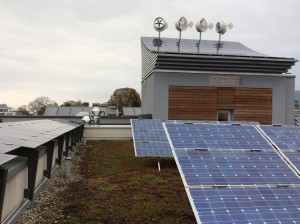
Photo-voltaic cells, wind turbines, and water heating cylinders on the roof of the Hotel Victoria (Dostal)
This morning, we had the opportunity to get a behind-the-scenes look at greening improvements made by the owners to the Victoria, making it a carbon neutral hotel. “It’s interesting that the hotel doesn’t seem any different when you walk in. There’s nothing that requires effort on the part of the guest” said Annika, in comparison to our previous conversations at Innovation Academy about making sure constituents understand and engage with technologies and practices comfortably.
We climbed to the roof to view the solar panels and tiny wind turbines, then trekked to the cellar to see the wood pellet burning heating system.
Our other guest commentator, Catherine, said that “this trip has made me realize the creative ways people are harnessing technologies that don’t occur to me, in ways that aren’t much harder than what we’re already doing.” Professor Don Barber was also able to share that some of the same cooling technology here is used at a Haverford athletic facility, which students will be able to visit on our return.
Our next tour was of Riesenfeld, which Catherine described as “a responsible community.” Once the open collection ground for the city’s sewer systems, the land was was intentionally reformed, “from the design contests about how it was going to be laid out, to all the different ways the architects made the structures energy efficient.” Annika notes that “it’s also important that there was a competition – it was digging into the skills that architects had to make it green. It was an important publicity element.” From four-story apartment buildings to single family homes, everything in the development has solar panels, insulated walls, and other eco-design features. There are green spaces, creeks, and many many playgrounds between rows of houses, all with pedestrian zoned walkways and bike storage sheds.
Catherine wondered about the circumstances that arose to allow such a project, though, and whether they are applicable elsewhere: “That takes a lot of time and effort, and a specific way of thinking about how to build a community and systems that will allow that kind of thought and intention [to living sustainable].” Annika also picked up on an interesting parallel, that “this region that focuses on sustainability also focuses a lot on children and childhood education in general, and specifically on sustainable practices, even though the population of Germany is aging.” Riesenfeld does have a central gymnasium (high school) and several kindergartens (primary schools) around which the housing developments are built, as well as a community center and ecumenical church right next to the tram stop. The focus is clearly on young families, who may find it less expensive to live here than closer to the city center.
Our last stop of the day was on the other side of Freiburg, at the Fraunhofer Institute for Solar Energy Systems, which is the largest solar R&D institution in Europe, and Annika’s favorite visit thus far. “I was a little upset that I’m not a natural science major or engineer today because I couldn’t contribute to their work, and I’m so excited by it.” Catherine found the visitor’s hall (where prototypes are displayed and photos are forbidden) “like being at Stark Industries, and [she] was geeking out a little bit.” We were given an overview of the kinds of projects the Fraunhofer undertakes, and the four areas of focus for their energy research: efficiency, conversion, distribution, and storage. Then our tour guide took us outside to the hydrogen fueling station, where we got to see a prototype of a zero emissions car, and Annika had some concerns.
“I was a little disappointed by the car… it looks like a normal car, but it has zero emissions, which was cool. But I feel like the issue is actually where the car parts are coming from, how they’re being manufactured, with what fossil fuels, and the impact that the car has before it’s even driven off the lot. And I asked the tour guide about it, and she was really focused on the zero emissions nature of the car. Looking at it more holistically, there’s a long way to go.”
Catherine added that “this trip is really focused on how communities do things, but what we use still has to be produced somewhere, and a lot of the production is done in an irresponsible way.”
Tomorrow morning, we leave Freiburg for St. Peter, a small mountain village about 20 km from the city, where we will sleep for the rest of our trip (though we’ll be back to visit other sites in Freiburg on Monday and Tuesday next week). I asked the students to reflect on their experiences thus far, and Annika brought up the vastness of climate change as an issue. “In class we’ve talked about problems now, and things that will occur and [the trip] has been helpful in making the issue much more accessible. Policy is implemented on national, state, and local levels, and seeing that [play out in Germany] has been more inspiring than a lot of the broader and gloomier readings we’ve done in class.” The stories we will hear in St. Peter (including our meeting tomorrow with a farmer who went out and bought a wind turbine because he was tired of waiting for the town to get one) bring that accessibility to an even more personal level, especially because Professor Bob Dostal has been living part time in the village for over a decade.
About our guest commentators:
Annika Cole is a sophomore International Studies major at Bryn Mawr College. She grew up surrounded by environmentally conscious and active adults, and was drawn to this 360 because she wanted to incorporate that education and awareness fostered in her into her curricular pursuits. As you may be able to tell, she’s having a great time on this trip, but she really loves her horse, and looks forward to riding again when we get back Stateside.
Catherine Rowen is a sophomore at Bryn Mawr College. She used to have nightmares about climate change as a kid, though she’s cooled down since then (unlike the planet!). As an archaeology major, she has been concerned that her studies focus on things that happened in the past to dead people, and was excited that this 360 gave her the opportunity to engage on these issues and a sense of what she could do as individual to make a difference. When she isn’t figuring out how to apply what she’s learning to archaeology, she’s playing cello in Blacktop, a band on campus.
Don’s Daily Haiku
Quote
Fraunhofer ISE
illuminates path to a
carbon-free future.

